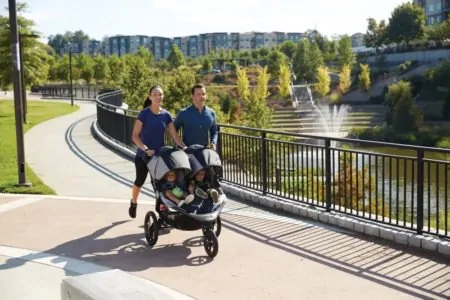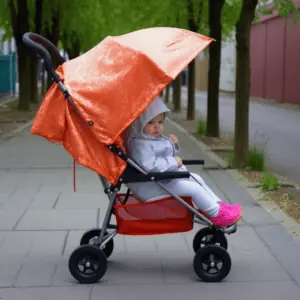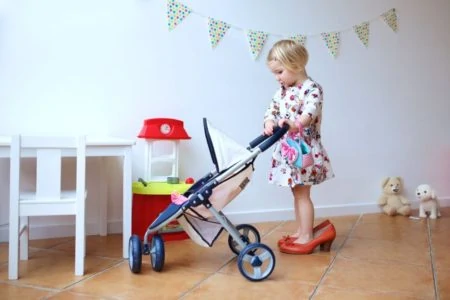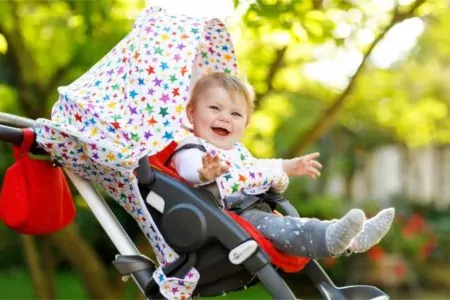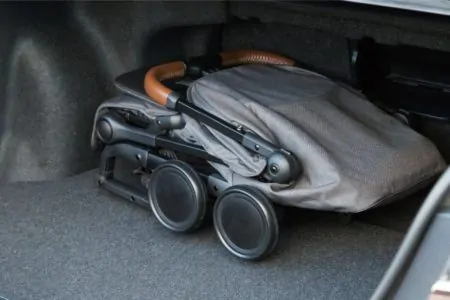Struggling to decide between a three-wheel or four-wheel stroller? You aren’t alone.
While the four-wheel stroller is the classic choice for many parents, the rise of the sporty three-wheeler has expanded the possibilities.
To make the right choice, you need to understand how they compare regarding handling, terrain, and daily convenience. Here is everything you need to know about the three-wheel vs. four-wheel debate.
Key Takeaways
- Three-wheel strollers offer superior maneuverability and are built for all terrains and active parents.
- Four-wheel strollers are generally more stable, affordable, and compact for folding and storage.
- Three-wheelers can be bulky and heavier, while four-wheelers often struggle on uneven surfaces like gravel or grass.
- Your decision should depend on your lifestyle, trunk space, budget, and whether you plan to jog with your baby.
Three-Wheel Strollers
The Advantages
1. Built for All Terrains
A three-wheel stroller is designed to handle almost any surface. These models are superb for off-roading, whether you are hitting the trails, walking on a sandy beach, or crossing a grassy park.
The suspension systems are generally more robust to protect your child from bumps and dips.
Compared to traditional strollers, the wheels are significantly larger. They are often made from rubber, are air-filled, and function like bicycle tires. This allows them to absorb impact on uneven ground much better than plastic wheels.
Make sure you check and pump the tires regularly to prevent a flat.
2. Ideal for Active Parents
Running or jogging is a fantastic way to get back into a fitness routine. A three-wheel stroller allows you to get a workout in with your kids in tow.
Safety First
While not all three-wheelers are true “joggers,” most jogging strollers utilize the triangular wheel configuration. The superior suspension and oversized tires provide a smooth ride at higher speeds.
3. Superior Maneuverability
If you are tired of stiff handling, the three-wheeled design will appeal to you. The front wheel usually swivels 360 degrees, allowing for ultra-smooth cornering and weaving around obstacles.
The steering requires less effort. You can easily push the stroller one-handed, which frees up your other hand for a phone, a drink, or holding an older child’s hand.
The Disadvantages
1. Bulky and Heavy
Although sturdy, three-wheelers are often larger to transport and store. While most fold down, the large rear wheels and longer frame make them cumbersome to load into a car trunk.
If you have a compact car, you might need to detach the wheels to make it fit. This can be frustrating when you are trying to manage a squirming toddler in a parking lot.
They are rarely lightweight. While great for pushing during a run, they are heavy to lift up stairs or onto a bus.
Measure Up
2. Higher Price Point
Three-wheel strollers are typically more expensive than standard four-wheel models.
If you are serious about jogging or outdoor activities, you need high-quality suspension and tires to meet those goals. This performance engineering usually results in a higher price tag.
3. Stability Concerns
While three-wheelers are safe, the triangular base has a slightly different center of gravity than a rectangle.
If you turn a corner too sharply at high speed, or if an older child climbs in unassisted, there is a slightly higher risk of the stroller tipping sideways compared to a four-wheel model.
Four-Wheel Strollers
The Advantages
1. Affordability and Selection
If you are working with a budget, four-wheel strollers offer the widest range of options. You can find everything from high-end luxury models to budget-friendly basics.
Since the four-wheel design is the industry standard, you have more choices in style. These range from complex travel systems to basic, lightweight umbrella strollers.
With such an extensive inventory, you are more likely to find a model that ticks every box on your wish list without breaking the bank.
2. Compact Fold and Storage
Four-wheel strollers are generally easier to collapse and take up less space. They are often lightweight, making them ideal for urban parents or those who travel frequently.
Some models are so compact that they fit into overhead airline bins. For example, the Pockit folds down to a tiny 11.8 x 7 x 13.8 inches and weighs under 10 pounds.
3. Maximum Stability
Four wheels generally provide better stability than three. Because the weight is distributed evenly across a rectangular base, the stroller is less likely to tip over sideways.
If you are navigating curbs or using public transport regularly, having two wheels on the ground at the front provides a sturdy, reliable feel.
The Disadvantages
1. Limited Terrain Versatility
A four-wheel stroller excels on flat, paved surfaces like sidewalks and malls. However, once you hit gravel, grass, or bumpy trails, they can be difficult to push.
Small plastic wheels tend to get stuck in cracks, and the lack of advanced suspension means your baby will feel every bump.
2. Not for Jogging
These strollers are not designed for running. While walking is excellent exercise (2), you cannot safely jog with a standard four-wheel stroller.
Attempting to run with one can be dangerous as the wheels may wobble violently at high speeds, and the lack of suspension could jostle your child.
Factors For Choosing a Stroller
Here are the essential aspects to consider before making your final decision:
- Lifestyle: Are you a city dweller navigating narrow store aisles, or do you spend your weekends on nature trails? Choose the wheel configuration that matches your daily environment.
- Safety: Beyond the wheel count, look for standard safety features. Test the five-point harness, ensure the brakes hold firmly, and inspect the frame for pinch points (3).
- Ease of Use: Test the fold mechanism before buying. Can you lift it into your car easily? Do you need two hands to steer, or can you manage with one?
- Comfort: Look for a seat with a deep recline for naps and an adjustable handlebar to accommodate parents of different heights.
- Maintenance: Strollers get dirty quickly. Check if the fabrics are removable and machine washable (see our cleaning guide). Also, consider that air-filled tires on three-wheelers require maintenance, whereas plastic wheels do not.
- Features: Consider the accessories you need, such as cup holders, rain covers, or a large storage basket for diaper bags and groceries.
- Age Appropriateness: Not all strollers are safe for newborns. Check if the seat reclines fully flat or if the model accepts an infant car seat.
Safety First

